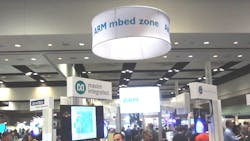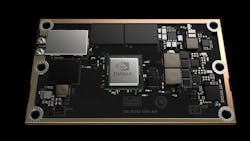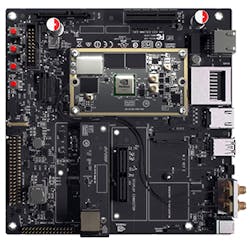Applications continue to demand more performance in smaller, more efficient packages. System-on-chip (SoC) solutions that blend GPU and CPU cores try to meet these expectations.
NVidia’s Jetson TX1 (Fig. 1) packs supercomputer performance into a credit-card sized module that is 50 mm × 87 mm. The module holds a TX1 SoC that is based on NVidia’s Maxwell GPU and ARM’s Cortex-A57 and Cortex-A53. The ARM cores support ARM’s big.LITTLE architecture (see “Little Core Shares Big Core Architecture” on Electronic Design). The Cortex-A57s share a 2 Mbyte L2 cache. The GPU has 256 cores that deliver 1 TFLOPS of performance. Performance is similar or better than an Intel Core i7 6700K Skylake CPU for many applications.
The module includes 4 Gbytes of LPDDR4 memory with a 25.6 Gbyte/s interface. A 16 Gbyte eMMC flash memory device provides built-in non-volatile storage.
The system supports 4K video encode and decode. It can also support 1400 Mpixel/s camera interfaces. For communications, there is a 1 Gbit Ethernet interface along with 802.11ac 2x2 Wi-Fi support. Bluetooth support is also available.
The Jetson TX1 plugs into a carrier board like the one pictured left, from NVidia (Fig. 2). The 400-pin carrier-board interface exposes peripheral support like a PCI Express Gen 3 socket plus SD card and m.2 sockets for additional storage. The carrier board and module are available in the Jetson TX1 Developer Kit priced at $599. The module alone is priced at $299. The system uses less than 10 W at 3.3 V.
The Jetson TX1 SDK supports CUDA 7.0. The SDK includes cuDNN, a CUDA-accelerated library for machine learning. It also includes the VisionWorks CUDA-accelerated library and framework for computer vision. This implements the OpenVX 1.1 specification and includes additional NVIDIA extensions. Drivers for OpenGL 4.5, OpenGL ES 3.1, and Vulkan are included.
Linux support is available for the Jetson TX1. It is ideal for a wide range of applications from robotics to gaming to automotive telematics.
About the Author
William G. Wong
Senior Content Director - Electronic Design and Microwaves & RF
I am Editor of Electronic Design focusing on embedded, software, and systems. As Senior Content Director, I also manage Microwaves & RF and I work with a great team of editors to provide engineers, programmers, developers and technical managers with interesting and useful articles and videos on a regular basis. Check out our free newsletters to see the latest content.
You can send press releases for new products for possible coverage on the website. I am also interested in receiving contributed articles for publishing on our website. Use our template and send to me along with a signed release form.
Check out my blog, AltEmbedded on Electronic Design, as well as his latest articles on this site that are listed below.
You can visit my social media via these links:
- AltEmbedded on Electronic Design
- Bill Wong on Facebook
- @AltEmbedded on Twitter
- Bill Wong on LinkedIn
I earned a Bachelor of Electrical Engineering at the Georgia Institute of Technology and a Masters in Computer Science from Rutgers University. I still do a bit of programming using everything from C and C++ to Rust and Ada/SPARK. I do a bit of PHP programming for Drupal websites. I have posted a few Drupal modules.
I still get a hand on software and electronic hardware. Some of this can be found on our Kit Close-Up video series. You can also see me on many of our TechXchange Talk videos. I am interested in a range of projects from robotics to artificial intelligence.



